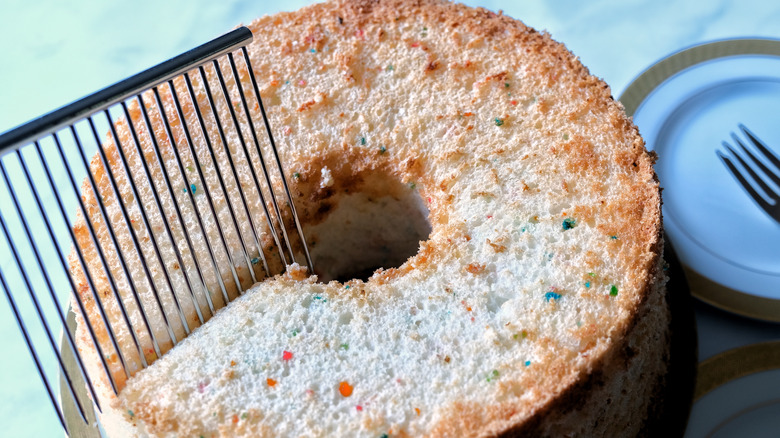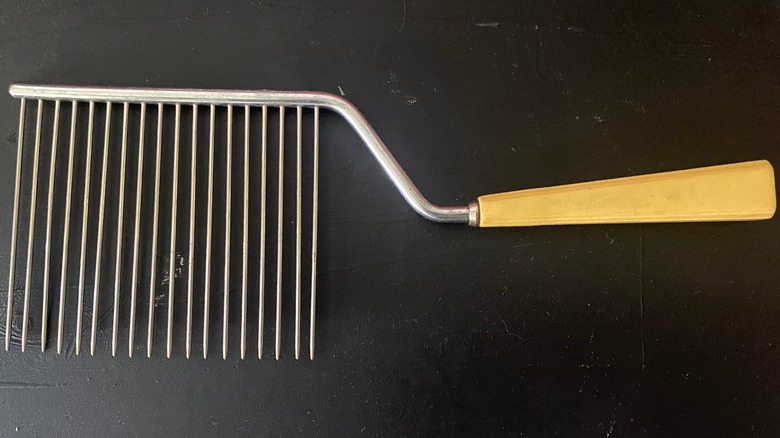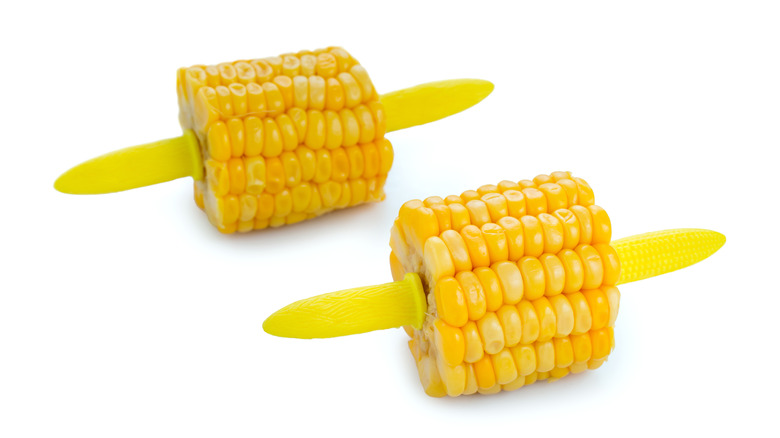The Strange-Looking Baking Tool That Once Preserved Delicate Cake Slices
Some culinary inventions feel truly heavenly, and angel food cake's appropriately one of them. It's a type of sponge cake — a fluffy dessert consisting of flour, sugar, and whisked eggs. Sponge cake is as delicate as it is thanks to those foamy eggs, which replace baking soda and powder as the leavening agent. Angel food cake in particular uses egg-white meringue along with the occasional cream of tartar, lemon juice, and/or salt. After baking within a tube pan (or similar), the result is as golden white as the pearly gates. Plus, since angel food cake doesn't use ingredients like butter, milk, or oil, it's one of the healthiest cakes there is. Variations do exist, of course, adding in candies, fruits, or spices as the baker sees fit, not to mention various dairy toppings.
This culinary delight didn't descend from the sky above in ancient times, though. Although its exact point of origin is unknown — some suggest the Midwest's Missouri, while others suggest the South's Kentucky — the general consensus is that the 19th-century United States spawned angel food cake somewhere within its eastern heartland. However, the complexity of its recipe and the labor involved may have limited the dessert's popularity for a time; whipping eggs with a balloon whisk took a lot of work. The invention of the rotary eggbeater, though, ensured angel food cake was all the rage by the dawn of the 20th century.
Only one problem remained: Cutting angel food cake tends to smoosh it.
The cake breaker takes the cake
Angel food cake isn't the only heavenly invention to have originated in America's heartland. In 1932, an Ohioan named Cale J. Schneider patented the cake breaker. Simply by looking at it, though, you might not recognize this thing as a culinary utensil. Considering its decorative handle plus its over-a-dozen, evenly-spaced-out, cylindrical teeth, one could assume the cake breaker was actually an old timey hairbrush. Its true purpose, nonetheless, was to slice delicate cakes such as angel food without squishing them, something which Schneider lamented happening to cake at a luncheon he attended with his wife.
Schneider's solution to this problem was promising enough for him to open a manufacturing plant that mass-produced the product. That decision paid off — for a while, at least — since Duncan Hines and Pillsbury Flour Mills bought hundreds of thousands of cake breakers over the course of two years. More than a hundred laborers worked nonstop to fill these orders, so the two companies could include cake breakers alongside their cake mixes. In the modern day, bakers still use similar specialty cutters known as angel food combs or rakes, which accomplish the same thing by sawing through the sponge.
Still, that's not even Schneider's only claim to fame!
Schneider also invented Kob-Knobs
Apparently, Cale J. Schneider had more than just angel food cake on the brain. He also created a product called Kob-Knobs, which were (naturally) sweet-corn holders. However, while the exact timeline for his patent is uncertain, it seems unlikely he was the first person to ever dream up corn holders, and he certainly wasn't the last.
Humans have eaten corn for a long time, but like angel food cake, the original corn holder appears to have originated in the 19th-century United States. The Victorians utilized two-tined corn forks. Then, in 1897, a pacifier-shaped handle with a trio of sharp prongs was patented, making it one of the earliest examples of a legally recognized corn holder. Ever since, people have created myriad blades and corkscrews of various designs. Some even go so far as to make holders look like mini pigs or ears of corn, bordering on ridiculous kitchen gadgets you don't actually need. Still, holders do make eating hot, buttery corn a little bit less messy, and they introduce pleasing aesthetics to the process — sort of like a cake breaker did for angel food cake.


